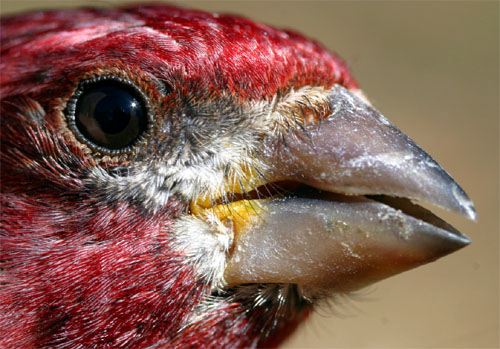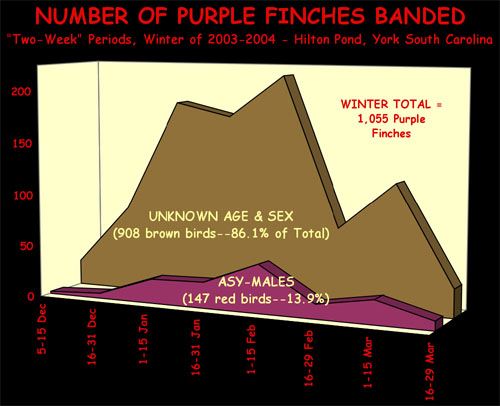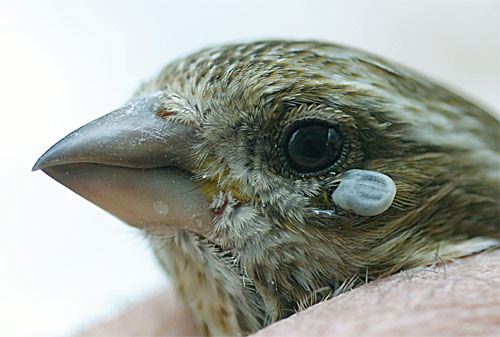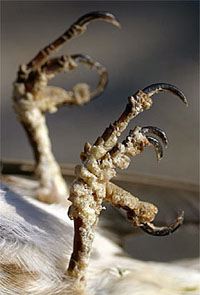THIS WEEK at HILTON POND
22-31 March 2004
Installment #216--Visitor #
(Back to Preceding Week; on to Next Week)
|
AN EXCEPTIONAL For the past several winters, Purple Finches have been relatively hard to find at Hilton Pond Center. The last big "irruption" was the winter of 1999-2000, when we banded 509 individuals and caught several returns from preceding years. Purple Finches seem to be facultative migrants--they don't bail out of their nesting grounds in the northeastern U.S. and Canada unless food is scarce and/or weather is severe. This is a very different strategy from that employed by "obligate" migrants such as Yellow-rumped Warblers that apparently fly south every fall from roughly the same breeding range as the Purple Finches. If Purple Finches are indeed opportunistic in their migratory behavior and their movements reflect harsh conditions, then the record-breaking numbers that appeared December 2003 through March 2004 at Hilton Pond Center must be a sign that snow cover was extensive and food was particularly scarce north of the Carolina Piedmont.
All text, charts & photos © Hilton Pond Center Having banded Purple Finches, Carpodacus purpureus, at Hilton Pond Center since the winter of 1982-83, we believe we have a pretty good handle on local trends for this species. Over the past 22 years, we've caught an average of 306 Purple Finches--even when we add in a couple of winters when we were away from Hilton Pond for much of the season. Previously, the all-time single-winter high for the species was 685 in 1986-87, but the season that just ended annihilated those numbers with 1,055 Purple Finches banded! This mind-boggling total came even though we had lengthy trips to San Francisco, Costa Rica, and Iowa during the period--including when the Center was hit in late February with record snowfall that undoubtedly would have driven even more birds to our traps. Despite these absences, our 2003-04 winter total was nearly 3.5 times the 22-year average, and brought the number of Purple Finches banded at Hilton Pond to 6,728--second only to House Finches with 6,849. In fact, these two finch species make up 31% of all birds banded at the Center, with 15% of the total being Purple Finches.
All text, charts & photos © Hilton Pond Center Several things about bountiful finch banding in the winter of 2003-04 piqued our interest. For one, Purple Finches followed their usual pattern of not appearing in good numbers until the winter was well underway (see chart below); only 11% (n=113) of the winter total arrived before the end of December, followed by 412 in January, 351 in February, and 179 in March. Our 22-year totals show that an even smaller percentage of Purple Finches were banded in previous Decembers: 327, or 5% of all that have been captured. Regardless of the year, these December numbers show that Purple Finches do indeed migrate long after most of the typical fall migrants move south.
All text, charts & photos © Hilton Pond Center Another unusual aspect of our Purple Finch banding in the just-completed winter was the relative dearth of raspberry-colored adult males. Purple Finches present a difficult sexing problem because males do not acquire red plumage (top photo) until late in their second summer; therefore, brown Purple Finches (just above) may be females of any age OR young males. According to federal Bird Banding Laboratory protocol, red males in autumn are aged After-Hatch-Year, but on 1 January become After-Second-Year. Brown birds in autumn are aged Unknown; on 1 January they all become After-Hatch-Year. Of the 2,702 Purple Finches banded from 1982 through June 1990 at Hilton Pond Center, 72.3% (n=1,953) were brown birds sexed as Unknown; the remaining 27.7% (n=749) were red males. In 2003-04, however, only 13.9% (n=147) of the Purple Finches banded were obvious adult males--only about half the expected number. This past winter, if a third of all brown Purple Finches (n=908) were adult females, a third were young females, and the remainder were young males, the percentages at Hilton Pond Center were close to a 2:3 ratio of males (42%) to females (58%); such a ratio would not be all that far from a 1:1 ratio that might be expected in a "monogamous" species such as the Purple Finch. However, for a 1:1 ratio to be accurate we would need to assume that male and female Purple Finches overwinter at the same locations and that survival rates of all age classes and sexes are equal. It is difficult--perhaps impossible--to derive this kind of information from available, limited banding data. We speculate that our most recent data reveal that the relatively small percentage of adult males we banded this past winter--
The winter of 2003-04 also brought numerous returns of Purple Finches we banded in previous winters (see table above). The majority of older birds were females (n=18), but the Methuselah of the bunch was a purple male--#2161-57623--originally captured on 22 March 1996 as an after-hatch-year brown bird of unknown sex. This individual was first recaptured on 15 February 1998, by which time it had acquired the red plumage of a male--an indication it had been a second-year bird in 1996, i.e., it hatched out in 1995. This individual subsequently returned on 16 January 2000 in his sixth year and was not trapped again until February 2004 when he had become a tenth-year bird, tying him for the honor of "Oldest Bird" ever recorded at the Center. (A female Northern Cardinal retrapped on 10 February 2004 had been banded as a hatch-year bird on 8 August 1995 and is also in its tenth year.) Our esteemed and ancient male Purple Finch was recaptured this year in the very same trap we first caught him in back in 1998--perhaps the ultimate in site fidelity. Even though the recent irruption of Purple Finches at Hilton Pond Center raises more questions than answers, we were pleased to capture so many of these winter migrants during the current calendar year. Thanks mostly to 908 Purple Finches so far in 2004, we've already caught a total of 1,176 birds in the first three months--compared to last year's disappointing shortfall of only 1,191 individuals banded for the whole 12-month period. It's nice to have such good numbers already, but what's more important is that all those Purple Finches we banded in 2003-04 greatly increase odds that some of these Hilton Pond birds will be encountered on their breeding grounds or elsewhere--perhaps helping us understand a little more about environmental and behavioral factors that send this interesting species to our winter feeders in the Carolina Piedmont.
All text, charts & photos © Hilton Pond Center NOTE: A rather late male Purple Finch was trapped on 16 April, upping the winter season total to 1,056. For more details about our research on Purple Finches and House Finches, please see Carpodacus finches in South Carolina's Piedmont: Migration, site fidelity, sex ratios, and longevity. You also may be interested in Lyme disease; Bird, ticks, and people. NOTE: Be sure to scroll down for an account of all birds banded or recaptured during the week, as well as some other interesting nature notes. "This Week at Hilton Pond" is written and photographed by Bill Hilton Jr., executive director of Hilton Pond Center for Piedmont Natural History. You may wish to consult our Index of all nature topics covered since February 2000. You can also use the on-line Search Engine at the bottom of this page. For a free, non-fattening, on-line subscription to "This Week at Hilton Pond," just send us an E-mail with Subscribe in the subject line. Please be sure to configure your spam filter to accept E-mails from hiltonpond.org. |
If you enjoy "This Week at Hilton Pond," please help support Hilton Pond Center for Piedmont Natural History. It's painless, and YOU can make a difference! (Just CLICK on a logo below or send a check if you like; see Support for address.) |
|
Make credit card donations on-line via Network for Good: |
|
Use your PayPal account to make direct donations: |
|
If you like shopping on-line please become a member of iGive, through which 1,200+ on-line stores from Amazon to Lands' End and even iTunes donate a percentage of your purchase price to support Hilton Pond Center.  Every new member who registers with iGive and makes a purchase through them earns an ADDITIONAL $5 for the Center. You can even do Web searches through iGive and earn a penny per search--sometimes TWO--for the cause! Please enroll by going to the iGive Web site. It's a painless, important way for YOU to support our on-going work in conservation, education, and research. Add the iGive Toolbar to your browser and register Operation RubyThroat as your preferred charity to make it even easier to help Hilton Pond Center when you shop. Every new member who registers with iGive and makes a purchase through them earns an ADDITIONAL $5 for the Center. You can even do Web searches through iGive and earn a penny per search--sometimes TWO--for the cause! Please enroll by going to the iGive Web site. It's a painless, important way for YOU to support our on-going work in conservation, education, and research. Add the iGive Toolbar to your browser and register Operation RubyThroat as your preferred charity to make it even easier to help Hilton Pond Center when you shop. |
|
|
|
|
|
|
SPECIES BANDED THIS WEEK: * = New species for 2004 WEEKLY BANDING TOTAL
YEARLY BANDING TOTAL
BANDING GRAND TOTAL VAGRANT HUMMINGBIRDS |
NOTABLE RECAPTURES THIS WEEK Chipping Sparrow (3) American Goldfinch (1) Northern Cardinal (1) Tufted Titmouse (1) House Finch (2) Purple Finch (3) Eastern Towhee (1) OTHER SIGHTINGS OF INTEREST --A male House Finch (see recaptures above) trapped on 27 Mar is now the oldest of its species on record at the Center. |
(Back to Preceding Week; on to Next Week)
|
|
|
Up to Top of Page Back to This Week at Hilton Pond Center Current Weather Conditions at Hilton Pond Center |
 post questions for The Piedmont Naturalist |
Join the |
Search Engine for |
|
|




 combined with a record-breaking total number of Purple Finches in 2003-04--means the species had a particularly good nesting season and produced many young, brown-colored birds. A very successful breeding year coupled with the snowy, cold weather that struck much of the Northeast in the winter of 2003-04 might have meant food resources were particularly scarce this winter, thus forcing a bumper crop of Purple Finches toward Hilton Pond. (What is surprising is that no other sites in the Carolina Piedmont seem to have reported as many Purple Finches as we had this winter, although without banding it's hard to know how many actually appeared at specific feeders elsewhere in the Carolinas.)
combined with a record-breaking total number of Purple Finches in 2003-04--means the species had a particularly good nesting season and produced many young, brown-colored birds. A very successful breeding year coupled with the snowy, cold weather that struck much of the Northeast in the winter of 2003-04 might have meant food resources were particularly scarce this winter, thus forcing a bumper crop of Purple Finches toward Hilton Pond. (What is surprising is that no other sites in the Carolina Piedmont seem to have reported as many Purple Finches as we had this winter, although without banding it's hard to know how many actually appeared at specific feeders elsewhere in the Carolinas.) One especially pleasing thing about the 1,055 birds captured during the recent winter is that none of them showed any signs of the contagious conjunctivitis eye disease that attacks several species of feeder birds--particularly House Finches, C. mexicanus. In addition, only ONE Purple Finch carried a discernible tick (above right)--a far cry from winters in the late 1980s when 2-5% of them might have at least one ectoparasite. The only noticeably ill Purple Finch this winter was a brown bird with scaly-leg (above left), a crusty yellow-white growth caused by tiny mites that burrow between the bird's leg scales.
One especially pleasing thing about the 1,055 birds captured during the recent winter is that none of them showed any signs of the contagious conjunctivitis eye disease that attacks several species of feeder birds--particularly House Finches, C. mexicanus. In addition, only ONE Purple Finch carried a discernible tick (above right)--a far cry from winters in the late 1980s when 2-5% of them might have at least one ectoparasite. The only noticeably ill Purple Finch this winter was a brown bird with scaly-leg (above left), a crusty yellow-white growth caused by tiny mites that burrow between the bird's leg scales.

 Oct 15 to Mar 31
Oct 15 to Mar 31 Please report your
Please report your
